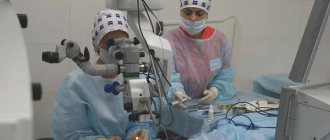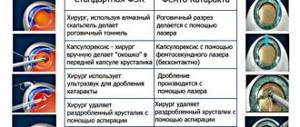For cataracts, the only effective treatment is surgery. It has been sufficiently developed, is performed on an outpatient basis and has virtually no complications. But many patients ask the question: is it possible to simultaneously replace the lens in both eyes at once? We will try to give a detailed answer.
Cataracts usually develop in both eyes. The pathological process occurs gradually and by the age of 60-70, approximately 60% of the population have this unpleasant diagnosis. Of course, visual function does not decrease completely in the same way - one eye will still see slightly better than the other, but these differences are not significant. In addition to age-related cataracts, congenital cataracts also occur, which are almost always bilateral.
It would seem that replacing the lenses of both eyes at once is the best solution. The advantages of this approach are obvious:
- 1) The time until complete restoration of vision is reduced
- 2) Binocular vision is not impaired - when one eye sees much better than the other
- 3) The patient experiences less stress, the emotional load on the body is reduced.
- 4) It’s easier to organize treatment - you don’t need to come to the clinic several times for consultations, it’s easier to resolve the issue with work and allocate time for the operation.
In 2009, special studies were conducted at the Presidential Administration Hospital on replacing the lenses of both eyes for cataracts. More than 400 patients were examined who underwent implantation of intraocular lenses at intervals of 4-5 days. Method of implementation: phacoemulsification. At the same time, modern antibiotics (fluoroquinolones) were used, all asepsis rules were observed, the highest quality materials and equipment were used, that is, everything possible was done to ensure that the rehabilitation period passed as quickly as possible. In general, the results were positive, but it turned out that the individual characteristics of each patient’s body are very important, which greatly influence the positive outcome of the operation.
Currently, ophthalmologists have come to the conclusion that replacing lenses in 2 eyes at once is not effective and is dangerous.
The exception is laser surgery for myopia and astigmatism.
Lens replacement surgery: choosing an implant
Surgery to replace a damaged lens involves the use of an implant called an “intraocular lens.” Its competent selection determines the success of the operation as a whole, affects the patient’s quality of life after it, and the functioning of his visual apparatus. The choice is made on an individual basis, based on the patient’s indications and financial capabilities. In this case, the doctor takes into account the parameters presented in the table below:
| Characteristic | Kinds | Peculiarities |
| Rigidity | Soft | They are more expensive, but they minimize trauma to the eye tissue during surgery, since they can be rolled up before installation, which will require a smaller incision. |
| Hard | They use hard material for manufacturing, are cheaper, but are not functional enough. | |
| Number of foci (foci are points that form image clarity: the more there are, the less need to use glasses or lenses) | Monofocal | Used for cataracts, they have only one point at which image clarity is achieved. Outside of it, objects remain blurred. Provide clarity at a distance, require the use of glasses for close-up work. |
| Bifocal | They have two focal points, which ensures clear images of objects at two fixed distances: near and far. Images of objects located between them may be blurry, so correction by optical means is necessary. | |
| Multifocal | They have three or more focuses due to the division of the implant into functional areas responsible for the quality of vision at different distances. They provide good visual effects and do not require additional correction by optical means - that is, in fact, they completely replace the natural lens. | |
| Accommodative ability (adaptation to focusing when contemplating objects that are located at different distances) | Non-accommodating | They are cheaper and are not able to change their curvature, as happens with a real lens, and therefore require the use of optical correction devices after surgery. |
| Accommodating | They are capable of changing curvature in the same way as a real eye lens does, they are more functional and convenient, but they are more expensive. Allows you to stop using glasses after surgery. |
Multifocal aspheric IOL AcrySofâIQ ReSTOR “Alcon” (USA)
The working substance of this artificial lens is hydrophobic acrylic, the material is transparent and elastic, which allows the lens to be inserted into the eye during surgery in a folded form, through a shortened incision of up to 1.9 mm. In the central part of the IOL there is a diffraction grating with a diameter of 3.6 mm, capable of creating two focal points - for looking into the distance and for contemplating objects at a distance of 25-30 cm. This technological solution with a pupil diameter of 2.0-2.5 mm ensures the same distribution light when looking into the distance and translating it to close objects, which in bright light allows the patient to see at any distance quite clearly without glasses. When the pupil dilates, the refractive structure on the peripheral surface of the artificial lens comes into play: with a 5-mm pupil diameter, up to 80-90% of the light flux is used for distance vision.
Since 2009, Alcon has presented and launched an improved model of the ReSTOR IOL - SN6AD1 (correction +3.0 D for near vision). The basic characteristics are similar to those of the base model SN6AD3, but the number of apodized rings is reduced to nine, which improves visual acuity at medium distances. The limit of clear vision near has moved away, however, to 38-40 mm.
Why is surgery performed?
An intraocular lens is an artificial lens consisting of optical and support elements. The first is a transparent lens that is biologically compatible with the tissues of the eye. On the surface of the second there is a diffraction zone, which allows you to obtain a clear image.
Techniques
All methods of surgical operations to remove cataracts are safe for human health, with a low percentage of complications. Despite the higher cost, patients more often choose one of the phacoemulsification methods due to the least trauma and quick recovery time.
Laser phacoemulsification
The most common method of treating cataracts, during which the lens that has lost its transparency is replaced with an intraocular lens. Its peculiarity is the destruction of the cloudy lens through the cornea without damaging it. During the procedure, a laser turns the cloudy lens into a liquid that is removed from the eye. And in its place an intraocular lens is installed.
IMPORTANT. The surgeon does not need to use instruments, which reduces the risk of complications.
Ultrasound phacoemulsification
The operation is performed through a small puncture (no more than 1.8 mm) with a diamond knife. Tweezers provide free access to the membrane in which the lens is located. An ultrasonic tip inserted into the eye destroys the lens, the crushed particles of which are removed by suction.
Through the same puncture, an intraocular lens in the form of a rolled tube is installed. In the eye, the elastic artificial lens straightens and takes the desired position.
No stitches are required during the operation. The puncture self-seals and tightens.
Extracapsular lens removal
Extracapsular lens removal is one of the first methods of surgical treatment of cataracts. During the operation, a wide incision is made in the cornea (10-12 mm), through which the lens is removed. An artificial one is implanted in place of the removed one, after which sutures are applied.
The operation is performed under anesthesia. The rehabilitation period is about 4 months.
Intracapsular lens extraction
The essence of the method is to remove the lens along with the capsule using freezing. A large incision is made in the cornea, and the lens is frozen to a special device - a cryoextractor.
This method is used when the lens is dislocated (displaced from its place).
Intracapsular lens extraction is a very traumatic method of lens removal. Currently practically not used.
Features of multifocal lenses
Up to 30% of patients implanted with a multifocal IOL report the appearance of iridescent outlines or glare from light sources. Such optical phenomena can create some inconvenience, but most patients get used to it within 2-3 months. Since such “flares” can create problems for professional drivers working in the dark, the installation of multifocal lenses is not recommended for people in this profession.
Sometimes, after installation of multifocal IOLs, the patient needs additional spectacle correction for near vision. In some cases, the quality of vision can be improved after implantation of an artificial lens using refractive surgery methods, including laser surgery (LASIK surgery).
You can get advice on installing multifocal intraocular lenses from specialists at the OkoMed clinic.
Selection by manufacturer
| Manufacturer country | Brand names | Types of implants | Peculiarities |
| Russia | bifocal | Provided free of charge if surgery is carried out under a compulsory health insurance policy | |
| Germany |
|
| They have an aspherical edge and offer a high degree of color rendering. Recommended by many domestic specialists for cataracts complicated by astigmatism. |
| USA |
| Multifocal accommodating | Capable of providing high quality vision in varying degrees of illumination. The back surface of the lens is shaped to focus light rays to one point on the retina, resulting in high image quality. |
| Great Britain | Rayner | Multifocal accommodating | They have an optimal shape and are made using multizonal aspheric optics technology, which allows you to avoid correction with glasses or lenses after surgery. |
Indications and contraindications for implantation of multifocal IOLs
An ophthalmologist at the Tarus clinic recommends using the lens for cataracts. A multifocal IOL helps not only restore the refractive power of the eye, but also cope with farsightedness that occurs after surgery. Cataract treatment is not the only reason for implanting a multifocal IOL. An appointment with a recommendation to install an artificial lens may also be required if:
- presbyopia;
- high degree of myopia and astigmatism.
A prerequisite for the operation is to be no older than 65 years. For myopia and astigmatism, an optical system is installed if the intrinsic refraction has reached a critically low value.
Contraindications to implantation of multifocal IOLs:
- inflammatory diseases of the apparatus;
- degenerative changes in the retina (diabetic, maculopathy);
- high degree of ametropia;
- subluxation of the lens.
MAKE AN APPOINTMENT WITH AN OPHTHALMOLOGIST
How is an artificial lens implanted in CELT?
Surgical intervention requires a mandatory preparatory stage. It consists of conducting comprehensive diagnostic studies and consultations with specialists in other fields (if necessary).
In order to minimize the risk of infection, the patient is prescribed antibacterial drops three to five days before surgery.
At the CELT clinic, the operation is performed under local anesthesia (anesthetic eye drops). Its stages include the following:
- fixation of eyelids using expanders;
- incision of the eyeball (2‒2.5 mm) and insertion of a special needle;
- the use of ultrasound to whip up the cloudy contents of the eye lens and remove crushed particles of the lens by aspiration;
- placing the implant in the vacant space, straightening it and filling it with liquid;
- applying a sterile dressing.
If the patient has no violations, he is sent home. It is important to understand that after surgery, vision and spatial orientation may be impaired, so it is advisable to come to the operation with an accompanying person.
What kind of disease is this?
Cataract is clouding and loss of transparency in the lens of the eye. Normally, for the image to focus on the fiber, the lens must be transparent. When clouded, it is not able to transmit light, and vision deteriorates until it is completely lost.
Depending on the location of the cloudiness in the lens, cataracts are:
- nuclear (in the center);
- cortical (periphery);
- bursal (in a capsule that covers the lens).
Etiology
Often, cataracts are the result of a disease of any organs, the entire body or surrounding tissues that disrupt the normal nutrition of the lens. Possible diseases that cause clouding of the lens:
- diabetes;
- hypertonic disease;
- glaucoma;
- high myopia;
- past infectious diseases;
- bad habits (alcohol, smoking).
Cataracts cannot always be divided according to etiological characteristics; they are most often classified according to localization, general clinical picture, course of the disease, and others.
For reasons, cataracts are distinguished:
- Age or senility. The most common type - up to 90% of all cases of the disease. The proteins that make up the lens begin to break down due to the aging process. This leads to clouding of the lens. The process of loss of transparency of the lens with age-related cataracts can take from 4 to 15 years. Depending on the individual characteristics of the body.
- Traumatic. Appears as a result of eye or head injuries.
- Congenital. Develops when intrauterine development is disrupted, caused by changes in the structure of proteins. Genetic changes occur due to infectious diseases of the mother in the first trimester, diabetes of the future parent, or due to her taking certain medications.
- Radial. Appears as a result of prolonged radiation exposure or while taking hormonal drugs.
Main symptoms
The main symptom of cataracts is the feeling of a person who sees everything through a veil, like through foggy glass. This symptom indicates damage to the central zone of the lens and the need for urgent surgical intervention. Additional symptoms:
- deterioration of visual acuity;
- increased sensitivity and intolerance to bright light;
- decreased night vision;
- the appearance of glare and spots near light sources;
- deterioration of color perception;
- difficulty in selecting glasses and their frequent change;
- rapid eye fatigue.
Treatment
Cataracts are treated with medication or surgery. Eye drops during drug treatment help improve metabolic processes in the lens of the eye, which can slow down the development of cataracts.
IMPORTANT. From the point of view of evidence-based medicine, the effectiveness of instillation has no evidence.
The only effective way to treat cataracts is surgery.
How and which artificial lens is better to choose
Modern artificial lenses are made from biomaterials whose optical properties are as close as possible to the lens of the human eye. The latest IOL models have a special filtering component that protects the retina from the negative effects of ultraviolet radiation. Also, modern artificial lenses contain a special component that prevents image distortion when contrast changes (for example, during day and night lighting).
In ophthalmology, several types of intraocular lenses are used. You can choose an IOL option based on different criteria:
- According to the method of vision correction,
monofocal
and
multifocal
lenses are used Monofocal IOLs are most often used to replace the lens of the eye during cataract treatment. Their peculiarity is that they provide high quality vision at distance or near, regardless of the degree of illumination. For example, if you choose to correct distance vision, you may still need glasses for reading or working at close range. Multifocal lenses are classified as premium lenses. They qualitatively imitate the functioning of the natural lens and correct vision, both near and far. - According to the method of refraction.
You can choose
spherical
artificial lenses that refract light differently at the center and at the edges.
Such IOLs create a scattering effect, which can lead to reduced image quality. Aspheric
are actively used in ophthalmology , in which the refraction of light is the same, regardless of whether it falls at the center of the lens or at the edge of the lens. - Based on the type of lens,
there are
hard
and
soft
IOLs. Today, doctors most often use soft lenses because of the ease of their implementation in place of the natural lens. To use a hard artificial lens, abdominal surgery is required.
You can also choose a lens with various additional functions, for example, an IOL with color filters and protection against the penetration of UV rays.
Most often, patients are confused about which lens is best when surgery is needed to treat cataracts. Reviews from patients and the attending physician will help you make your choice.
After diagnosis, the ophthalmologist will tell you in detail about the advantages and disadvantages of certain intraocular lenses and advise which type of IOL is best suited for your individual case. Also, the doctor, based on the selected type of intraocular lens, provides information in advance about how much it costs to replace the lens during cataract removal.
Lens replacement surgery: postoperative period
The duration of the recovery period varies from person to person. As a rule, patients notice improvement in vision within a few hours; the maximum effect is achieved after approximately 30 days. In order to minimize the risk of complications, it is necessary to follow certain rules:
- Rinse the operated eye daily with sterile water;
- wear a bandage for 7 - 14 days;
- put antiseptic drops into the eyes;
- during the first days, avoid alcohol consumption and physical activity;
- do not lift anything weighing more than three kilograms;
- sleep on the side opposite the operated one;
- sleep on your back if the operation was performed on both eyes;
- minimize visits to baths and saunas in the future.
Advantages of visiting the Tarus clinic
The Tarus Eye Clinic is one of the few in Ukraine that uses the most modern diagnostic equipment. Due to this, the exposure time on eye tissue is minimal, which reduces the likelihood of a long recovery period and the development of complications. The laser vision correction center in Odessa has licenses and certificates ,
giving the right to provide assistance using modern technologies. Documentation confirms qualifications that meet European standards. This gives specialists the right to carry out the following manipulations:
- treatment and removal of cataracts;
- laser vision correction;
- installation of different types of IOLs;
- retinal coagulation;
- treatment of visual impairment in children;
- examination of the visual apparatus.
The purpose of an ophthalmologist is to cope with the patient's vision problems in a short time. Medical has all the capabilities for this.
SIGN UP FOR COMPREHENSIVE VISION DIAGNOSTICS
Basic rules for rehabilitation after surgery
The main rule in the postoperative period after surgery to replace the lens for cataracts, according to reviews, is the inadmissibility of a large load on the eyes. In the first month, it is better to stop driving a vehicle.
You should also not take walks in the first few days to prevent dirt particles from getting into your eyes and to prevent infection of the entire body, weakened by the operation. Smoking and drinking alcohol should be completely avoided.
Adhering to recovery mode
Bed rest after surgery is not mandatory. Lack of sleep must be avoided. Ideally, sleep duration should be ten hours. This is necessary to restore strength. It is best to sleep on your back, on a fairly high pillow.
In the first few days after surgery, you must adhere to a certain diet.
The body is weakened after surgery; it is necessary to ease its energy expenditure on the digestive process as much as possible so that more strength remains for recovery.
That is why you should follow a diet during the postoperative period that includes liquid porridge, chicken broth, and well-mashed dishes. In the future, you should definitely include in your diet more foods containing vitamins A, C, E and D, and unsaturated fatty acids.
Carrying out hygiene procedures
Lens replacement for cataracts: the postoperative period (reviews are given at the end of the article) involves carrying out hygienic procedures. In this case, it is recommended to adhere to the following rule: the head should not be tilted forward, but, on the contrary, tilted back.
Glasses that correct astigmatism have an uneven surface, cylindrical or spherocylindrical. Cylindrical lenses are used to correct mild simple astigmatism.
Lenses with a spherocylindrical surface are prescribed in cases where astigmatism is accompanied by myopia or farsightedness. These glasses have two optical powers to correct the main and concomitant vision pathologies.
It is worth saying that glasses are not the best way to correct astigmatism. They require a lot of getting used to.
In the first days they cause dizziness and headache. Typically, glasses to correct astigmatism are selected in three stages.
At first, lenses with low optical power are prescribed, after a few months stronger glasses are selected. After getting used to them, the final version is prescribed, completely correcting astigmatism.
Toric contact lenses are a convenient and more effective alternative to glasses for astigmatism.
Contact lenses to correct astigmatism are called toric lenses. Their surface perfectly follows the shape of the cornea, which ensures good vision with any form of astigmatism.
The contact optic with a toric design is clearly stabilized on the eyeball and does not move during wear. The main advantage of such ophthalmic products over glasses is that you don’t need to get used to them.
In addition, they do not narrow the field of view, do not fall off the face, do not fog up, and therefore do not interfere with an active lifestyle.
Toric contact lenses are selected together with an ophthalmologist. You can buy them in any salon or online store. The most popular ophthalmic products for correcting astigmatism are lenses from the following manufacturers:
- Alcon - Air Optix for Astigmatism;
- CooperVision - Biomedics Toric;
- Sauflon - Bioclear Toric;
- Carl Zeiss - Contact Day 30 Compatic Toric.
You can purchase other models as well. The Ochkov.Net website presents a huge selection of contact optics for astigmatism correction.
Laser surgery is performed for astigmatism of more than 3 diopters and for mild degrees of astigmatism, when a person does not want to wear contact lenses and glasses. Laser correction is carried out as follows: the doctor forms a flap from the epithelial layer of the cornea and moves it to the side in order to gain access to the inner layers of the cornea.
After this, the cornea is given the correct shape by a laser beam. Once the correction is complete, the flap is returned to its place.
There are several laser techniques used to treat astigmatism. They differ in the method of forming the corneal flap. Thus, with photorefractive keratectomy the flap is completely removed, but with LASIK it is preserved. The technique is selected based on medical indications.
Laser correction is carried out only after the eye has completely healed. The rehabilitation period after lens replacement lasts approximately six months. During this entire time, the patient must regularly visit the ophthalmologist's office. When the cornea has completely healed, the doctor will determine the degree and form of astigmatism and prescribe laser surgery.
Astigmatism is a fairly serious complication that must be treated. If left uncorrected, this refractive error can cause strabismus and amblyopia. It is worth considering that replacing the lens for many patients is the only way to preserve vision, so the presence of hypothetical complications should not be a reason to refuse surgery.
Lens replacement surgery: possible complications
The development of complications is possible due to refusal to follow the doctor’s recommendations after surgery or due to medical errors. The most common of them:
- retinal detachment;
- corneal edema (goes away on its own);
- development of secondary cataracts (laser correction required);
- increased intraocular pressure (requires the use of special eye drops and timely treatment, as it can lead to the development of glaucoma);
- infection (occurs extremely rarely and requires treatment with antibiotics).
Preparation for implantation
After the first consultation with an ophthalmologist, a treatment plan is drawn up. It includes several stages:
- Psychological testing.
- Assessment of general health.
- Measurements of anatomical parameters of the eye.
- Assessment of the condition of the fundus and ophthalmological structures.
- Definition of retina, cornea.
The Tarus Clinic has the ability to comprehensively examine the condition of the visual system in a short time. Thanks to this, the patient can count on a quick solution to his eye problem.
Reviews
Valentina, 57 years old:
For a long time I was afraid of lens replacement surgery. As a result, based on reviews, I chose the clinic and the laser phacoemulsification method. The whole procedure took about 25 minutes. It didn’t hurt at all, I was more afraid. Now my vision has returned to me, I see everything as before. I am very pleased that I chose laser phacoemulsification.
Mikhail, 65 years old:
With age, cataracts developed. At first I didn’t attach any importance to this, but when my vision deteriorated so much that the doctors couldn’t help, I went to the hospital. I was prescribed eye drops, but they didn't help. Then my daughter took me to another clinic, where I was offered surgery. I agreed, there was nothing to lose. After passing all the tests, I was given consent to the procedure. It’s been 3 months since I had it done and I can see it perfectly. The scales fell from my eyes. I am very grateful to the doctors of the clinic.
Vera, 23 years old:
After a head injury, my vision deteriorated sharply. I consulted an ophthalmologist, who diagnosed catarrh. I was shocked, I thought that this disease only affects older people and it is incurable. They reassured me that now they perform operations in half an hour, after which everything returns to normal. And so it was: my vision returned within 1.5 weeks after the procedure. I would like to advise everyone: there is no need to be afraid, it is better to have surgery once than to have bad vision for the rest of your life.










